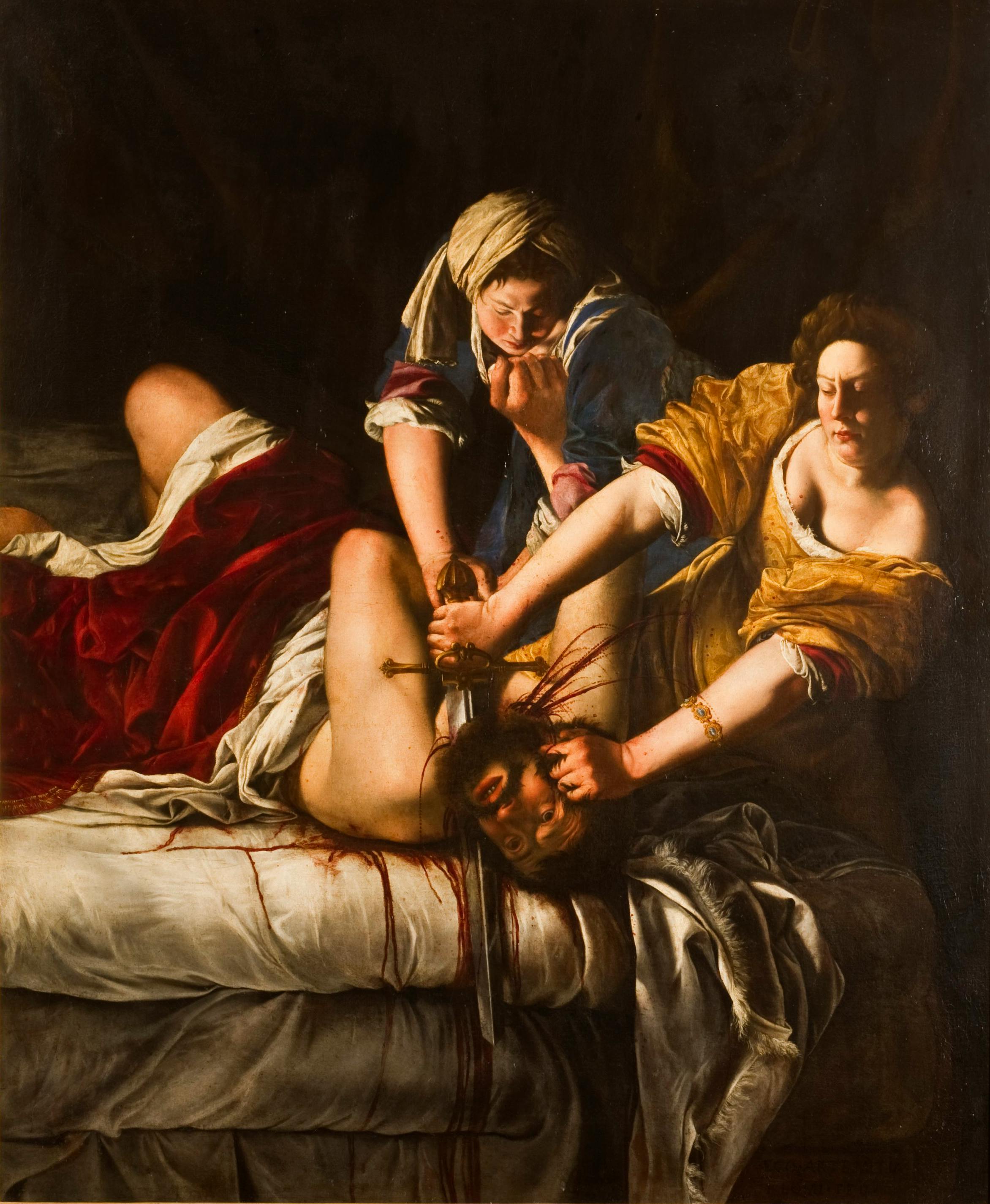Judith Slaying Holofernes: A Look into Baroque Paintings
 |
| Judith Slaying Holofernes, Artemisia Gentileschi (1620) |
Many people are familiar with Caravaggio’s Judith Beheading Holofernes, but not many know about Artemisia Gentileschi’s version of the story, Judith Slaying Holofernes. The tale goes like this: a young widow, Judith, from the Jewish city of Bethulia, wished to save her people from Nebuchadnezzar’s army (Beheading Holofernes, Uffizi). She was invited into their camp under the pretense that she would give them information to ensure their victory. Holofernes, a general of the army, was captivated by Judith’s beauty and invited her to dine with him. After a few too many glasses of wine, Holofernes fell asleep on his bed, where Judith, with the help of her maid, Abra, cut off his head (Camara).
Why is this piece of art important? Judith Slaying Holofernes was painted in a time when few women painters were recognized, let alone apprenticed. Gentileschi’s version of the story is much more brutal and human than Caravaggio’s. Her attention to detail, the expression on Judith’s face, and the blood spurting from Holofernes’s neck are much more enunciated than in her contemporary’s. Caravaggio portrays Judith as indifferent, albeit disgusted with what she’s doing, and he depicts Abra, Judith’s maidservant, as an old woman off to the side while Judith beheads the general. He even makes Judith distance herself from her actions, portraying her as dainty and unsure of her actions. Gentileschi, however, paints Judith and Abra directly in the action. Judith’s face is one of determination, the face of a woman who knows exactly what she’s doing. She also portrays Abra as helping Judith, not standing off to the side but holding down Holofernes as she brutally severs his head from his body. Pay attention to how Gentileschi portrays Judith as well. Judith is not a dainty, frail girl as she is in Caravaggio’s version; she’s a hardened woman overcome with grief and determined to save her people. Her brows are wrinkled slightly, and her knuckles are white as she steadies her hands on her sword and Holofernes’s head. Gentileschi’s use of tenebrism casts a haunting glow on the three figures. It accentuates the determination on Judith and Abra’s faces and starkly contrasts Holofernes’s confused, anguished expression. Gentileschi’s depiction of the beheading was also more realistic than Caravaggio’s. Where Caravaggio kept the blood and brutality minimalized to highlight his daintiness of Judith, Gentileschi takes a more naturalistic approach. The blood gushing from the wound and the white bedding dripping with crimson are two examples from this piece that are much more brutal and realistic than Caravaggio’s. Judith Beheading Holofernes, Caravaggio (1598-1602)
The comparison between Caravaggio’s and Gentileschi’s versions of the same story isn’t for nothing. Artemisia’s father and mentor, Orazio, was Caravaggio's old friend and follower. In her youth, Gentileschi would have frequently seen his depiction of the story and, according to Dr. Esperança Camara, would’ve “inspired, and perhaps even challenged, the young Artemisia.”
Camara, Dr. Esperança. Artemisia Gentileschi, Judith Slaying Holofernes, Smarthistory, 19 July 2015, smarthistory.org/gentileschi-judith-slaying-holofernes/.
“Judith Beheading Holofernes by Artemisia Gentileschi.” Uffizi Galleries, 22 Nov. 2023, www.uffizi.it/en/artworks/judith-beheading-holofernes#description.
Straussman-Pflanzer, Eve. Violence and Virtue: Artemisia Gentileschi’s Judith Slaying Holofernes, The Art Institute of Chicago, Chicago, Illinois, 2013. ISBN 978-0-300-18679-6.
Wow! I love that you compared two pieces of the same story. Amazing how differently portrayed they are. I agree with your assesment that Gentileschi's protrayal is most likely more accurate. The brutality, facial expressions, even body posture is more real than those shown in Caravaggio's painting. The women are leaning into Holofernes, using body weight, working, determined. Caravaggio shows them as leaning away, appearing to use the same strength and interest as one would to say, pick a flower. Excellent choice and comparisson!
ReplyDeleteYou did a lovely job of pointing out the shift in renaissance art during reformation and how art evolved during the Counter reformation. This blog post displayed a great deal of information regarding bother pieces and I really enjoyed your analysis of the art. I completely agree, Artemisia Gentileschi's Judith Slaying Holofernes is far more dramatic, with more movement and expression. There is a greater sense of struggle and tension in the image she creates. The counter reformation really pushed that the emotion in this sacred scene capture the audience, and Gentileschi has achieved this very feat. The story of Judith is told in Gentileschi's painting, a meaning and a depth to Judith's actions that Caravaggio falls short of telling. In Caravaggio's painting the skill is immaculate, but I would need the background of the story to fully admire it, where I resonate with Judith immediately in Gentileschi's piece. Thank you so much for sharing!
ReplyDelete